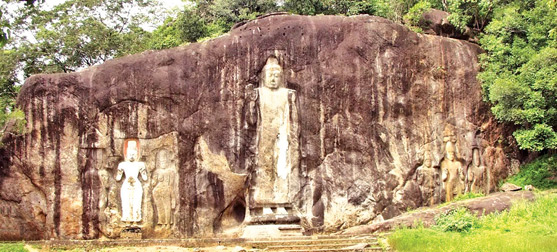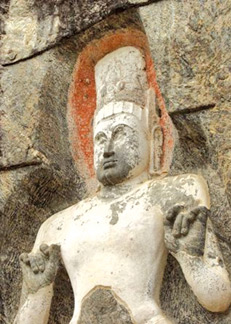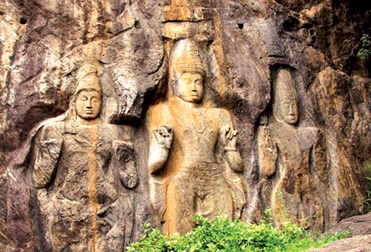Breathtaking Buduruwagala rock carvings - an ornate wonder
By Mahil Wijesinghe
When you enter the forest area, suddenly the placid lake of
Buduruwagala is dramatically revealed through a dark arch of a forest
canopy. The white skeletons of dead trees which still stand and the
variety of birdsí nests on the trees in the tank instil a sense of
serenity to the moment.
|

The Buduruwagala rock depicting a gallery of rock carvings |
The water, with its shallow marshy tracts is the perfect feeding and
wading habitat for a wide variety of birds. Some of the birds that can
be spotted are cormorants, serpent-eagles and ebbs. When the drought
prevails in the area, herds of elephants can be spotted in the vicinity
of the Buduruwagala tank.
Having turned off to the left from the Wellawaya town, on the A-4
highway which runs to Thanamalwila, Jagath Sirisena, my friend and Range
Forest Officer of Moneragala and I were on our third and final leg of
our Moneragale tour which was Buduruwagala. We travelled about five
kilometres on the Thanamalwila road and turned off to the left at a
dusty junction in Buduruwagala, a farming village near Wellawaya in the
awe-inspiring mountain range of the Uva Province. From here we tried to
find our way to the Buduruwagala rock carvings.
The Buduruwagala rock, a popular tourist destination in Sri Lanka
which is featured in all its splendour in travel and photography books,
seemed to have the shape of an elephant, with seven sculptured colossal
figures in the heart of the jungle. It is possibly one of the most
photographed sites in the country.
|

A Buddha statue |
Eventually, we met an old man who, with a wry smile, pointed to us
the direction of the beaten track to Buduruwagala, which led us to the
unexpected, ornate wonder. I prefer to explore ancient sites by myself
and let my thoughts stray thinking about the ancient glory. My friend
and I walked along the dusty road to Buduruwagala, drinking in the
beauty of the rural community of the area, flanked by drought-stricken
paddy fields and farmersí huts as well as some modern houses, inevitable
developments due to commercialisation and increase in population.
All around us was lush vegetation and the breathtaking landscape of
the Buduruwagala mountain range was attention-grabbing.
As shown in the directions to the site, We walked about 200 meters
under the forest canopy and suddenly, through the trees, we glimpsed the
huge, elephant-like rock boulder with carvings. During our stay at the
Buduruwagala shrine, we experienced a salubrious and serene atmosphere,
which was truly breathtaking. I saw several visitors rest under huge
trees for a while; they may have probably felt like meditating and
resting their minds at this place.
Here we saw a unique assembly of seven figures in high relief,
depicting the highly developed artistic skills of 8th or 9th Century
sculptors.
The colossal Buddha statue in the centre is 51 feet tall, perhaps the
tallest in Sri Lanka, and is carved out of the living rock.
It is flanked on both sides by two groups of three figures.
Archaeologists believe that this Buddha is a reproduction of the
Dipankara Buddha and the other figures are Bodhisatva Awalokethishwara
and his consorts.
These Bodhisattva images have been found elsewhere such as Maligawila,
Sithulpahuwa and Weligama in the deep South and are believed to be
images of the remarkable creations of the Mahayanists of Ruhuna.
There is a deep dent in the middle of the rock close to the bottom of
the Buddha image, which is in the shape of a huge clay lamp and it is
believed that oil leaks from the rock cavity.
|

Buduruwagala rock carvings |
A middle-aged person in the Buduruwagala village said that when he
was a small boy, he had seen oil leaking from the rock cavity and that
he used to anoint his head with oil.
At present, the re is no oil leak and the only evidence of oil having
leaked from the spot before is a discolouration. The area is still
blackish in colour.
Observing the carvings, we understood that ancient sculptors had used
white plaster to cover the stone images to achieve a more refined and
artistic value to the carvings. Even today, looking at the Bodhisatva
image at the right side of the Buddha image, one notices a portion of
white plaster in the stone image, as well as a scanty piece of plaster
on the main Buddha statue.
Seeing the gallery of stone carvings on the isolated rock in a silent
forest, we were impressed not only by the serene beauty of the images
but also the enchanting greenery of the verdant jungle, the waters and
shadows of dead trees at the Buduruwagala tank. |

